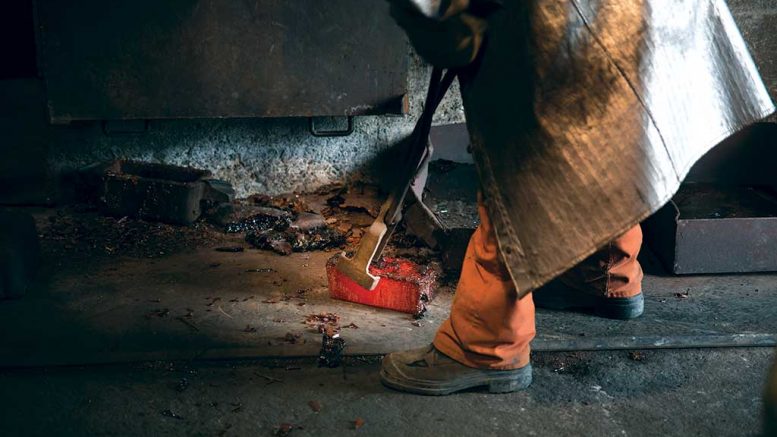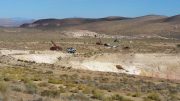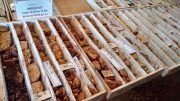Since the Prospectors and Developers Association of Canada (PDAC) conference wrapped up in early March, Monarch Gold (TSX: MQR; US-OTC: MRQRF) has fielded calls from three mining companies about possible joint ventures to explore its Croinor gold project, 55 km east of Val-d’Or in Quebec.
The project has a fully permitted past-producing mine that is open at depth, and the junior has already found mineralized zones northeast of the main deposit on the 151 sq. km property.
“We hold all of it, and are seeking partnerships because it’s too vast for us,” Jean-Marc Lacoste, Monarch Gold’s president and CEO, says. “We have had three serious enquiries — two majors and a mid-tier. They knocked on our door because of the potential of the Croinor deposit.”
The deposit has 236,000 oz. gold in the measured and indicated category (804,600 tonnes grading 9.12 grams gold per tonne) and 38,400 oz. gold in the inferred category (160,800 tonnes averaging 7.42 grams gold), but the known resource has been chased down only to a depth of 350 to 400 metres, Lacoste says, and is open at depth.
“It needs a lot of exploration to potentially double or triple the resource by drilling much deeper, and following different vein systems,” he says. “We also discovered some very interesting potential within the vicinity of the main deposit in January 2017, when we found a 25-metre zone of 8-gram material sitting about 500 metres from the current deposit.”
That discovery to the northeast is named Gold Bug, and Lacoste is confident that more exploration will find mineralization on other parts of the property.
“We have hit several targets within 2 to 3 km of the deposit, so, with a property of this size, which is roughly 15 to 20 km long by 4 to 5 km wide, it gives you an idea of how big this property could be.”
Lacoste also notes that mining entrepreneur Rob McEwen invested in the company in May 2016 — largely on the upside he saw at Croinor — and holds 5% of the junior.
“He came in with a cheque and said he really liked the property, and there was so much to explore,” Lacoste says. “He’s a big fan, a big shareholder and is very active. I had a one-hour meeting with him at his office during PDAC to give him an update on what Monarch has been doing.”
Lacoste notes that Monarch updated a prefeasibility study (PFS) on the Croinor deposit in January 2018 that did not include any drill results after November 2015, which now totals over 30,000 metres of drilling.
The newer study outlines a mine life of just over three and a half years, including pre-production of 602,994 tonnes at a grade of 6.66 grams gold per tonne. The study estimates total production of 125,889 oz. gold at a total cost of US$902 per oz., based on US$1,280 per oz. gold.
The company says there’s a lot more work to be done and expects to sign a joint-venture deal before year-end.
After completing an initial drill program of 20,000 metres (89 drill holes) at Croinor last year, the company said in October it would drill another 8,300 metres to test undrilled areas between planned stopes to add tonnage.
The supplementary program will include drilling around the periphery of the deposit to follow up on positive assay results and extend the resource to the west, where it remains open.
Near-mine exploration drilling has returned intercepts such as 22 grams gold over 1.1 metres in hole 18-653, which was drilled 41 metres up-plunge from the nearest planned stope. Hole 18-649, a down-dip hole drilled into the host diorite to test the deposit at depth, returned 9.59 grams gold over 1 metre, indicating the deposit is still open to depth.
Other holes testing two areas targeted for bulk sampling on the 38-metre level and the 76-metre level returned positive results. On the 38-metre level, hole 18-636 cut 88.60 grams gold over 1 metre. In the 250-foot level hole 18-647 intersected 25.92 grams gold over 3 metres. The two levels are accessed by ramps from two open-pits.
The Cronior gold deposit, which was discovered in 1940, is hosted by the synvolcanic Croinor Sill, which is 60 to 120 metres thick and hosted within volcanic rocks of the Assup Domain.
The deposit is characterized by gold-rich lenses consisting of quartz-carbonate-tourmaline-pyrite veins, altered pyritic host-rock material, and tectonic breccia (pyritic host fragments within a quartz-carbonate-tourmaline-pyrite vein).
Known showings at Croinor include Gold Bug, Cronior-Trench 2, Bug Lake, Pershon, Rocheleau-3, Rocheleau-5, T13, Kenda Pershing, Ansley, Onyx-Tavernier, Jolin and Brett-Tretheway.
The Croinor property lies in the Haig, Pershing, Tavernier, Tiblemont and Vauquelin townships, 27 km east of the nearest town of Louvicourt, in the municipality of Senneterre.
Its location in the eastern part of the Archean Abitibi greenstone belt in the southern Superior Province of the Canadian Shield makes it even more attractive, Lacoste says.
Elsewhere in the Abitibi, Monarch is also exploring its McKenzie Break gold property, 35 km north of Val-d’Or and 20 km from the company’s fully permitted, 750-tonne-per-day Beacon gold mill.
The McKenzie Break property is also close to Monarch’s Camflo gold mill, which has a capacity of 1,600 tonnes per day. Camflo was processing mineralized material from Monarch’s Beaufor gold mine, 20 km northeast of Val-d’Or, until the mine was put on care and maintenance in August 2018.
In March, Monarch released the second set of assays from its 2018 drill program at McKenzie Break, which explored the known lenses and the periphery of the multi-vein Green and Orange zones, which are within a 500-metre radius of each other.
Highlights include 93.80 grams gold over 1 metre from 140 metres downhole in 18-216; 20.12 grams gold over 3 metres from 360 metres below surface in 18-205; 25.20 grams gold over 1 metre, 165 metres downhole in 18-213.
Most of the campaign was to follow the Green and Orange zones deeper, and of the 61 holes drilled (14,000 metres) 17 holes reported visible gold.
“The good news is that we started hitting good grades at 300 and 350 metres below surface, which is very shallow, when you consider the upside potential of drilling at 400 and 500 metres’ depth,” Lacoste says. “We like the fact that it’s shallow from zero to 350 metres. A lot of the deposits in the Abitibi go down to 1.5 to 2 km deep, so we like the idea of the potential at depth.”
Last June Monarch calculated a pit-constrained indicated resource of 48,133 oz. (939,860 tonnes grading 1.59 grams gold) and inferred resources of 14,897 oz. (304,677 tonnes averaging 1.52 grams gold).
It also outlined an underground indicated resource of 53,448 oz. (281,739 tonnes at 5.90 grams gold) and an underground inferred resource of 49,130 oz. (270,103 tonnes at 5.66 grams gold).
Lacoste notes that Monarch has made the discovery a bit bigger and has hit deep extensions to the current known zone.
“We were able to extend the radius of the known resource by about 100 metres to the north, to the east and to the south, so this is basically an extension of the resource by 100 metres, and that is big news for us. We’re growing laterally, and we feel that nothing has been done at depth to this date, so we believe the known resource could very well be a lot bigger than we anticipated.”
Monarch bought the McKenzie Break property from Agnico Eagle Mines (TSX: AEM; NYSE: AEM) in 2017. Agnico had acquired it several years earlier from Red Kite Financial, but hadn’t done much, if any, work on the property, Lacoste says.
“We had our eyes on that property for more than four years, because we looked at acquiring it from Red Kite at the time,” he says. “But Agnico came in and bought it because it was close to the open pit at Malartic. The reason we were so interested in it is because it’s only 20 to 30 km from our Beacon mill, where we could send most of the material.”
The 3.3 sq. km McKenzie Break property consisting of nine mineral claims is accessible year-round via Route 397 and a gravel road, and is 9 km south of the rail link between Senneterre and Barraute.
As part of its acquisition of McKenzie Break, Monarch picked up the Swanson gold property from Agnico. Swanson, 65 km from Monarch’s Beacon mill, consists of one mineral lease and 129 claims covering 51 square kilometres. It also has a 500-metre ramp down to a depth of 80 metres.
“There’s a big pit at 2 gram material, and if the price of gold goes up significantly, this pit will become very valuable to us, because it could easily bring in 25,000 oz. gold a year for three or four years,”Lacoste says. “We had a National Instrument 43-101 resource completed in mid-2018 and we got a recommendation of work to be done on the property. So we believe we could go ahead on these recommendations in a more robust market.”
If and when Monarch decides to advance Swanson, Lacoste says, the work would be in two phases. “We’d first do a 20,000-tonne bulk sample, so we could do more metallurgical testing and understand the resource block model. Phase two would be a preliminary economic assessment.
Swanson has a combined pit-constrained and underground resource of 1.75 million indicated tonnes grading 1.85 grams gold for 104,100 oz. gold, and inferred pit constrained and underground resources of 74,000 tonnes of 2.96 grams gold for 7,100 contained oz. gold.
Monarch’s flagship asset, however, is its Wasamac project, a 7.6 sq. km property about 15 km west of Rouyn-Noranda, with measured and indicated resources of 2.6 million contained oz. gold (29.86 million tonnes grading 2.70 grams gold) and inferred resources of 293,900 oz. gold (4.16 million tonnes of 2.20 grams gold).
A feasibility study completed in December 2018 outlines an 11-year mine life producing 142,000 oz. gold annually. Cash costs are estimated at US$550 per oz. and all-in sustaining costs of US$630 per ounce.
Initial capex is pegged at $464 million, including $230 million for a mill and tailings facility.
Monarch is ready to start the permitting process at Wasamac.
The deposit has strong exploration potential, Lacoste argues, as it has only been explored down to 800 metres.
“Since most of the zones are wide — from 30 to 70 metres in thickness — and the material is disseminated in the intrusion, any discovery below by a few metres can mean big size ounce potential,” he says. “Because the Wasamac project is a bulk-mining system, contrary to the typical narrow vein mining with high grade in the Abitibi, with a width closer to 1 to 3 metres, any extensions we may encounter at 100 metres below the current structures could add 10% to 20 % to the current 2.6 million oz. — providing, of course, that the grade and width are similar.”
Monarch has a few notable shareholders: Alamos Gold (TSX: AGI; NYSE: AGI), which owns 19%; other partners, 23%; Quebec Funds, 10%; Nemaska Lithium (TSX: NMX), 7%; Oxbridge Group (Greg Chamandy), 5%; Rob McEwen (Evanachan), 5%; and management, 2%.
At press time, Monarch was trading at 25¢ per share within a 52-week trading range of 14.5¢ to 38.5¢.
The junior has 239 million shares outstanding for a $60-million market capitalization.
Monarch Gold changed its name from the demi-French “Monarques Gold” in January.






Be the first to comment on "Monarch Gold targets multiple projects"